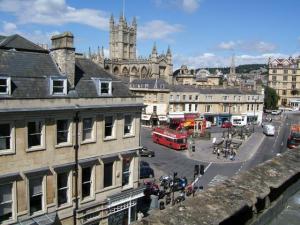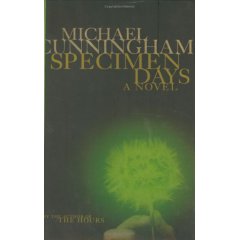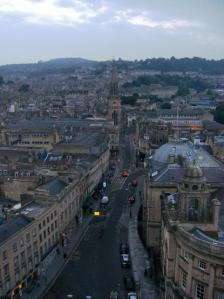
I visited Bath, England during spring break of my senior year in college. That was over a quarter century ago, so my memories are “historical” rather than “contemporary.” They may even shade into “speculative” since memory warps with each recollection, transforming real locations into alternate realities. I’ll be able to gauge the extent of my idiosyncratic warping when I return to Bath next June. I’m teaching a creative writing class for Advanced Studies in England, a study abroad program for U.S. college students.
My course is “Writing Bath: Historical, Contemporary, Speculative Fiction,” but I considered calling it “Right Here, Only More So.” There’s a Laurie Anderson song (also from a quarter century ago) that opens with the line: “Paradise is exactly like where you are right now . . . only much, much better.” And there’s an even older truism about science fiction: “The future is now, only more so.” That’s a particularly good definition of speculative fiction, and combined with Anderson’s spin on place, it sums up my approach to fiction writing.
I open my introductory course (the one I teach in Virginia, not England) with an observation exercise: list sensory details. Since we’re sitting in a classroom, the results usually include the ticking of a clock, the scent of chalk, the glow of fluorescent bulbs, the press of a chair back against your spine. If you dig a little deeper, those details get much, much better: the conch-shell murmur of AC vents, the convergence of shadows as a pen tip touches paper, the pendulum sway of an earring.
Any location can yield unlimited details. And though a classroom in rural Virginia is as good a place as any to dig down, imagine if the classroom is in Bath, England. Those are Roman ruins under the sensory top soil. So after exploring the contemporary, I’ll send my students off in time machines to land anywhere they like in the two thousand years of Bath history. And when they get back, we’ll spin the controls in the opposite direction and speculate about the city’s diverging futures.
Although historical fiction and science fiction seem like opposites—one’s in the past, the other the future—they’re both not in the present, and so, unlike contemporary fiction that borrows from immediate reality, they are alternate worlds that have to be imaginatively constructed. Contemporary fiction is an imaginatively constructed alternate world too, but you get to cheat a bit because readers will do more of the setting work by filling in familiar details themselves. But the past and future require more authorial effort.
The past of historical fiction isn’t the past. It’s an invented past. What are Roman sandals made of? How do they lace up? Where do they chafe? I have no idea. But my students will also take a course called The Romans in Britain, and combine that with contemporary interpolation (ie, it hurts to walk on a blister), and suddenly first-century Bath will be within strolling distant. The Triumph of Georgian Bath will give them enough architectural know-how to conjure other moments of history into equally concrete existence.
Speculative fiction at first seems comparatively boundless. History books are filled with verifiable events, while the future is unwritten. But the future is made of the same stuff as any historical story: the present, only more so. What does a hovercraft sound like when it’s landing? I have no idea. But I can pluck details from my world—the whir of my half-clogged lawn mower—because the mundane really is much much better for building something non-existent. And if you do your building in Bath, England, your range of the mundanely contemporary is also sunk deep in the paradoxically here-but-not-here historical. Three worlds, one place.
I get no points for creativity though. Michael Cunningham approached New York the same way for his 2005 novel Specimen Days.

The first section explores the gothic past of the Industrial Revolution, culminating in the Triangle Waist Factory fire of 1911. The second is a contemporary police procedural plotted around a suicide bomber in the wake of 9/11. And the final part leaps into New York’s distant future of androids and lizard-like aliens. Deepening the interconnections of the three-in-one setting, manifestations of the same three characters appear in each version of New York, weaving a larger plot through the whole of the novel.
You can try this yourself at home. Any home. Everyplace in the world contains a world of plots just under its surface, and its pasts and futures are disguises for its own Right Now. Cunningham could have written Specimen Days in my hometown of Lexington, Va. But I’m glad he didn’t. I’m also glad my class and I will be digging into Bath, England for our inspiration. I hope to find a ghost of my twenty-year-old self wandering the Roman ruins.
[And if you’re attending one of the ASE’s affiliate or participating colleges, you might consider meeting the ghosts of Bath past, present, and future with us. More on that here.]

